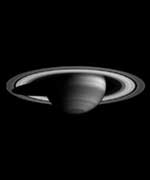
Image credit: NASA/JPL/Space Science Institute
A montage of Cassini images, taken in four different regions of the electromagnetic spectrum from the ultraviolet to the near-infrared, demonstrates that there is more to Saturn than meets the eye.
The pictures show the effects of absorption and scattering of light at different wavelengths by both atmospheric gas and clouds of differing heights and thicknesses. They also show absorption of light by colored particles mixed with white ammonia clouds in the planet’s atmosphere. Contrast has been enhanced to aid visibility of the atmosphere.
Cassini’s narrow-angle camera took these four images over a period of 20 minutes on April 3, 2004, when the spacecraft was 44.5 million kilometers (27.7 million miles) from the planet. The image scale is approximately 267 kilometers (166 miles) per pixel. All four images show the same face of Saturn.
In the upper left image, Saturn is seen in ultraviolet wavelengths (298 nanometers); at upper right, in visible blue wavelengths (440 nanometers); at lower left, in far red wavelengths just beyond the visible-light spectrum (727 nanometers); and at lower right, in near-infrared wavelengths (930 nanometers).
All gases scatter sunlight efficiently at short wavelengths. That’s why the sky on Earth is blue. The effect is more pronounced in the ultraviolet than in the visible. On Saturn, helium and molecular hydrogen gases scatter ultraviolet light strongly, making the atmosphere appear bright. Only high altitude cloud particles, which tend to absorb ultraviolet light, appear dark against the bright background, explaining the dark equatorial band in the upper left ultraviolet image. The contrast is reversed in the lower left image taken in a spectral region where light is absorbed by methane gas but scattered by high clouds. The equatorial zone in this image is bright because the high clouds there reflect this long wavelength light back to space before much of it can be absorbed by methane.
Scattering by atmospheric gases is less pronounced at visible blue wavelengths than it is in the ultraviolet. Hence, in the top right image, the sunlight can make its way down to deeper cloud layers and back to the observer, and the high equatorial cloud particles, which are reflective at visible wavelengths, also are apparent. This view is closest to what the human eye would see. At bottom right, in the near-infrared, some methane absorption is present but to a much lesser degree than at 727 nanometers. Scientists are not certain whether the contrasts here are produced mainly by colored particles or by latitude differences in altitude and cloud thickness. Data from Cassini should help answer this question.
The sliver of light seen in the northern hemisphere appears bright in the ultraviolet and blue (top images) and is nearly invisible at longer wavelengths (bottom images). The clouds in this part of the northern hemisphere are deep, and sunlight is illuminating only the cloud-free upper atmosphere. The shorter wavelengths are consequently scattered by the gas and make the illuminated atmosphere bright at these wavelengths, while the longer wavelengths are absorbed by methane.
Saturn’s rings also appear noticeably different from image to image, whose exposure times range from two to 46 seconds. The rings appear dark in the 46-second ultraviolet image because they inherently reflect little light at these wavelengths. The differences at other wavelengths are mostly due to the differences in exposure times.
The Cassini-Huygens mission is a cooperative project of NASA, the European Space Agency and the Italian Space Agency. The Jet Propulsion Laboratory, a division of the California Institute of Technology in Pasadena, manages the Cassini-Huygens mission for NASA’s Office of Space Science, Washington, D.C. The Cassini orbiter and its two onboard cameras, were designed, developed and assembled at JPL. The imaging team is based at the Space Science Institute, Boulder, Colorado
For more information about the Cassini-Huygens mission, visit http://saturn.jpl.nasa.gov and the Cassini imaging team home page, http://ciclops.org.
Original Source: CICLOPS News Release
